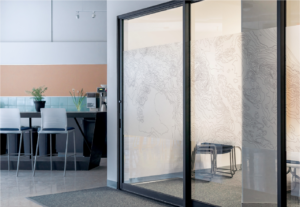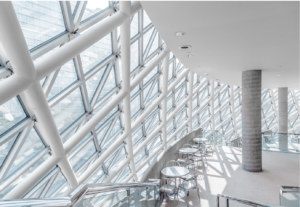Construction of green and sustainable buildings is the trend that has been picking up across the world to provide a better environment for present and future generations. Right from the designing, construction to the future use of the building, everything about green architecture is designed to positively impact the internal and external environment around it. These buildings are designed to ensure the correct balance between the lower impacts on the surroundings without compromising the needs of the users.
The relation between glass and spaces
Glass holds as great potential in transforming any space practically, aesthetically and futuristically. Apart from the very common aspect of glazing in architecture, glass plays a very important part in many other aspects of designing too. It creates beautiful harmony between the outside and inside environment of the building. Glass creates a welcoming environment, shows the true self of the internal spaces. It draws upon the outside work through visual stimulation creating a link between different spaces. That’s the only reason glass is used at the entrance of most buildings to invite the outside world and make them feel comfortable.

- Partitions: Spatial aspects of the building are enhanced using glass as the material inside the building. The trends of reduction, minimalism features the use of glass as one f the principle material as it redefines the visual elements. It creates an illusion of partition, office spaces explain this kind of illusion very precisely.
- Sliding walls and glass doors: with modern technology it is now possible to create completely frameless panels in huge sizes. Frameless and expansive glazed walls and doors create the illusion that an interior space is expanding beyond horizons. It creates an intense effect on living spaces.
- Glass floors: with new heat strengthened, toughened glass, it is now possible to create a structural glass floor. It creates a vertical flow between two floors of the building which can be used as a visual feature to connect to spaces that is one above the other.
- Skylights and glass roof: skylights offer a great view of the sky and provide an independent source of light. It reduces the need for artificial light sources creating a great source of the natural interior lighting plan.
Impact of glass on sustainable architecture
Glass has not been always considered as a sustainable material. It was no good with insulation capabilities and energy saving, hence disturbing the internal environment of the building. But the beliefs have changed with advances in double glazing, lamination and many other new kinds of glass available which have turned it into great energy-saving material. Glass is recyclable and is manufactured through the highly efficient process which does not have any negative impact on the environment. It has extraordinary properties that one can never find in any other building material. It is transparent, chemically inert, strong, easy availability and very affordable. The major abilities for which glass is preferred this widely are:
Energy Saving: As glass is a very good heat insulator, it can be used extensively in cold places. New technologies of inert gas insulation, lamination, infrared coating, and double glazing have been used to control the thermal insulation of glass for every kind of climatic conditions.

Energy generation: Transparent, colorless, low-cost photovoltaic glass panels have revolutionized solar power generation. It is an innovative technology that produces electricity that can reduce energy consumption through cooling, heating and artificial lighting.
Recyclable: Considering that the glass is manufactured from sand, it is easily available everywhere at low costs. Glass is very recyclable material; 50 to 80 percent of the glass can be recycled and used again and again. This ability of glass makes it a very crucial factor for the sustainability and the circular economy of the building.
Natural lighting: There is no better substitute for natural light. Glass brings sunlight to the internal environment of the structure. Modern glass helps in controlling the intensity of light, luminance and unnecessary glare to the inside buildings. Such innovation has helped to save a lot of money by taking advantage of the sun’s abundant light.
If used right, glass is a beautiful friend of nature. It provides a huge advantage through the conservation of resources and widespread acceptance. Glass is one of the best economical market products for building material.



